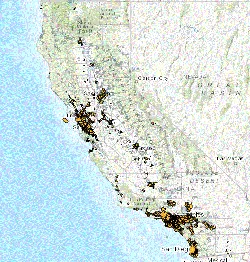Statutory Determinations for Limiting Jurisdictions’ Abilities to Restrict Development
California’s housing crisis has reached historic proportions. In response, recently passed California laws limit the ability of specified cities and counties to restrict development based on a statutory determination of each jurisdiction’s status.
To accelerate housing production, SB 330 (Statutes of 2019) makes changes to land use and zoning law to remove barriers and impediments to building new housing in urban areas of the state. To increase transparency and certainty in the development application process, SB 330 allows a housing developer to submit a “preliminary application” to a local agency for a housing development project. Submittal of a pre-application allows a developer to provide a specific subset of information on the proposed housing development ahead of providing the full amount of information required by the local government for a housing development application. Upon submittal of an application and a payment of the permit processing fee, a housing developer is allowed to “freeze” the applicable fees and development standards that apply to their project while they assemble the rest of the material necessary for a full application submittal. SB 330 requires the California Department of Housing and Community Development (HCD) to develop a standardized form that applicants for housing development projects may use for the purpose of satisfying the requirements for submittal of a preliminary application if a local agency has not developed its own application form. HCD has also provide a template that local governments may use to develop their own preliminary application form.
SB 330 (Statutes of 2019) requires the California Department of Housing and Community Development (HCD) to develop a list of cities (“affected cities”) and census designated places (CDPs) within the unincorporated county (“affected counties”) that are prohibited from taking certain zoning-related actions, including, among other things:
- Downzoning certain parcels.
- Imposing a moratorium on development.
- Imposing design review standards that are not objective.
The law also requires jurisdiction-wide housing replacement when housing affordable to lower-income residents is demolished.
View a full list of all the bill’s provisions.
Pursuant to Government Code section 66300, HCD has updated the list of affected cities and counties due to new data obtained from the 2020 Census.
Definition of "affected cities" — SB 330 defines an "affected city," as any city, including a charter city, that is located in an urbanized area as designated by the United States Census Bureau. Based on HCD’s determination, 452 of the 482 cities in the state are identified as affected by the provisions of SB 330.
- Affected Cities (PDF) (*Updated: 4/19/2023)
Definition of "affected counties" — "Affected counties" are defined as a CDP that is wholly within the boundaries of an urbanized area. Based on HCD’s determination, 141 CDPs in 22 counties are identified as affected by the provisions of SB 330.
- Affected Counties (PDF) (*Updated: 4/19/2023)
How the determination was made — In order to make the determination of Affected Cities and Affected Counties, HCD used census data and geographic information systems (GIS) software to find all incorporated cities and towns that are located within urbanized areas. HCD used census data and GIS software to find all CDPs that are wholly within the boundaries of an urbanized area.
- View the data sources for the lists.
View map of Affected Cities and Affected Counties.
*The list of affected cities and counties may be updated once on or after January 1, 2021 to account for changes in urbanized areas or urban clusters due to new data obtained from the 2020 census.
SB 423 (Wiener, 2023) creates an opt-in program for developers that allows a streamlined approval process for developments in localities that have not yet met their housing targets, provided that the development is on an infill site and complies with existing residential and mixed-use zoning. Participating developments must provide at least 10 percent of units for lower-income families. All projects over 10 units must be prevailing wage and larger projects must provide skilled and trained labor.
Please note: Pursuant to SB 423 (Chapter 778, Statutes of 2023), any jurisdiction that did not adopt a housing element that has been found in substantial compliance with housing element law are subject to streamlined ministerial approval for qualifying proposed developments with at least 10% affordability. To confirm housing element compliance, visit the Housing Element Compliance Report.
- Final Updated Streamlined Ministerial Approval Guidelines (PDF)
- Streamlined Ministerial Approval Process (SMAP) Dashboard (updated daily beginning 6/30/2025)
- For the following please see the “Dashboard” page of SMAP Dashboard:
- Summary of which jurisdictions are not currently subject to SMAP, which are currently subject to SMAP for developments with at least 10 percent affordability, and which are currently subject to SMAP for developments with at least 50 percent affordability
- Infographic summarizing which jurisdictions are currently subject to SMAP for developments with at least 10 percent affordability, which are currently subject to SMAP for developments with at least 50 percent affordability, and which are not subject to SMAP
- For a summary of Annual Progress Report (APR) permits please see the following pages of the dashboard:
- Determination Data: Replaces the “SB 423 SMAP Determination Data” tab from the “Annual Progress Report Permit Summary” file released in prior years
- Determination Summary: Replaces the “5th Cycle Raw Data” and “6th Cycle Raw Data” tabs from the “Annual Progress Report Permit Summary” file released in prior years
- For the following please see the “Dashboard” page of SMAP Dashboard:
- Streamlined Ministerial Approval Process Determination Methodology (PDF) — Updated 06/30/2025 — Additional detail on the determination methodology and background data
- 2025 SMAP Determination Webinar Recording — coming soon — A recording of HCD’s 7/16/2025 webinar reporting on the results of the 2025 Streamlined Ministerial Approval Process Determination


